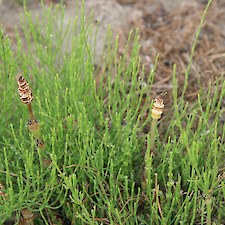 Field horsetail
Field horsetail
Common name: Field horsetail
Botanical name: Equisetum arvense
Management programme: Exclusion
Field horsetail is native to Europe, Asia and North America. It is thought to have been accidentally introduced to New Zealand with a shipment of iris rhizomes from Japan in the 1920s.
Fossil records of field horsetail show the plant has stayed the same for over 300 million years!
Why is it a pest?
- Field horsetail is extremely difficult to get rid of once established and is resistant to most herbicides.
- It reduces crop yields drastically and is reported, from overseas research, to be toxic to horses, cattle, and sheep.
- It forms dense stands in a wide range of damp habitats, blocking waterways and contributing to flooding and silting.
- Field horsetail is dispersed by water, soil movement, and humans.
Where is it found?
- No known sites in the Bay of Plenty.
- Prefers bare damp areas such as pastures, river, and stream sides, especially silty, sandy or gravel sites.
What does it look like?
- Fertile stems are produced in early spring and are whitish to light brown, ending in a yellowish to brownish cone.
- Sterile stems start to grow after the fertile stems have wilted and persist through summer until the first autumn frosts. They are green, very rough to touch and resemble pine seedlings.
- It has jointed hollow stems and the leaves grow in whorls around the joints. No flowers.
- All aerial plants die back in winter.
- Extensive, deep, freely branching rhizomes with round tubers.
What are the rules?
Exclusion
Field horsetail is classified as an Exclusion pest. This mean that it is not known to be present in the Bay of Plenty. The Bay of Plenty Regional Council is responsible for managing new incursions of field horsetail into the region.
How do you get rid of it?
Let us know if you think you have seen this plant or have it on your property by emailing stop.pests@boprc.govt.nz or alternatively call 0800 884 880.
Images




